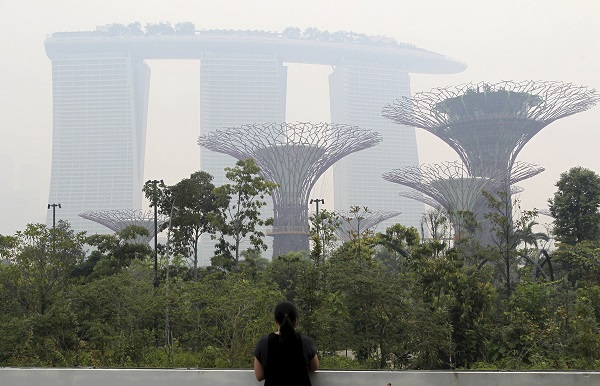Worsening haze from Indonesia angers Singapore, tourists

his photo taken on Monday, June 17, 2013 shows the Marina Bay Sands hotel and the Supertrees at Gardens By The Bay covered in haze. The Pollutant Standards Index, Singapore’s main measure to determine air quality, crept into the “unhealthy” classification Monday as smoke from roaring blazes on Indonesia’s Sumatra island drifted across the sea and cast a gray pall over the city-state’s skyscrapers. AP/Wong Maye-E
SINGAPORE — Singapore’s smog crisis from Indonesian forest fires worsened Wednesday as air pollution levels reached a 16-year high, triggering a run on medical masks and angry complaints from foreign tourists and locals.
The city-state’s Pollutant Standards Index soared to 172 at mid-afternoon, well past the officially designated “unhealthy” threshold of 100, according to the National Environment Agency (NEA) website.
It was Singapore’s most severe haze reading since September 1997 when the number peaked at 226. Anything above 200 is considered “very unhealthy” particularly to the elderly, young children and people with heart and lung disease.
“We are going to leave Singapore two days early because we are having trouble breathing,” said Zac Kot, 40, a business owner from the United States who was on holiday with his wife and two young girls.
Indignant Singaporeans attacked their own government on the web for its handling of the problem. Disposable medical masks flew off drugstores’ shelves as consumers and companies bought them in bulk and placed orders for more.
Article continues after this advertisementEven tourists from Indonesia — traditionally the largest source of visitors to Singapore — protested about the smoky haze from Sumatra island, where some farmers and plantations deliberately set off fires to clear land for cultivation.
Article continues after this advertisement“It’s not very good, and it’s getting harder to breathe. I just don’t know where to go,” said Rangga Adisapoetra, 30, a risk management executive from Indonesia’s main island Java who was attending a mobile communications and broadcasting expo.
“Maybe tomorrow, I’ll visit Universal Studios. Since we are in Singapore, we might as well visit attractions,” he told AFP, temporarily lifting a grey face mask to speak as he waited outside a convention centre for his friends.
The pollution problem peaks during the June-September dry season, when monsoon winds transport thick clouds of smoke from Sumatra to neighboring Singapore and Malaysia.
Singapore is a densely populated city-state of 5.3 million inhabitants which welcomed 14.4 million visitor arrivals in 2012 — 14.5 percent of them from Indonesia.
Air quality also worsened on Wednesday in Malaysia, where readings in seven areas monitored by the Department of Environment entered “unhealthy” levels by midday, mainly in the country’s south near Singapore.
Just four areas were rated “unhealthy” the day before.
Southeast Asia’s worst haze crisis took place in 1997-1998, causing widespread health problems and costing the regional economy billions of dollars as a result of business and air transport disruptions.
Singapore officials continued to take to social media on Wednesday to address citizens’ rising anger over the smog.
Foreign Minister K. Shanmugam strongly rebutted online criticism that the Singapore government was being soft on Indonesia — a sprawling archipelago of more than 240 million people.
“Every country is sovereign and we can’t intervene in the actions in other countries,” he said in a Facebook posting on Wednesday.
“The burning is taking place in Indonesia. What do you think Singapore can do about that?” he wrote.
Shanmugam and Singapore’s environment minister Vivian Balakrishnan on Tuesday spoke with their Indonesian counterparts to emphasize “the urgency of the situation” and offer help to fight the fires in Sumatra, a government statement said.
On Monday, an Indonesian forestry ministry official, Hadi Daryanto, shifted some of the blame to Malaysia and Singapore, saying their palm oil companies that had invested in Indonesia were also responsible.
Golden Agri-Resources (GAR), a palm oil plantation company listed on the Singapore Exchange with operations in Sumatra, said it has a “zero burning policy” since 1997 that its local contractors must comply with.
GAR’s website says it is the world’s second largest palm oil plantation company with a total planted area of 464,300 hectares (1.15 million acres) including smallholders and a market capitalisation of $6.0 billion as of March.
“Only mechanical means such as excavators and bulldozers are used in our land preparation,” a spokesman told AFP.
“If illegal fires are started near our estates we take prompt action to put them out and report to the local authorities.”